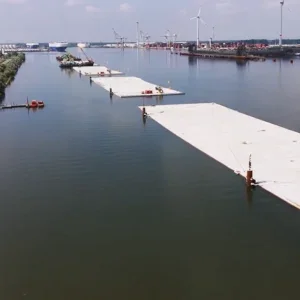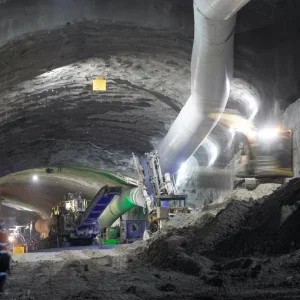By the beginning of 2016, the giant TBM "Bertha" in Seattle is expected to restart boring on the delayed, central waterfront section of the USD 3.1bn Alaskan Way Viaduct Replacement project, following repairs to the 57.5ft (17.53m) diameter machine.
To prepare, Bertha has been undergoing an unusual, if not unique, experience for any TBM, not least the world’s largest: she is being buried to commence boring.
A 120ft- (36.5m-) deep shaft was constructed to reach the TBM, allowing its vital front section to be brought to the surface for repairs. Following the work, the TBM was reassembled, the cutterhead was turned and other no-load tests were completed. The last task is load testing to relaunch the TBM for its drive below the viaduct.
To that end, the shaft has been backfilled with sand and controlled density fill, allowing Bertha to bore once more. Slowly. For a few hundred feet only, at first.
Even though the TBM, first launched two-and-a-half years ago, still has most of its relatively short, 1.7mile- (2.7km-) long tunnel drive yet to finish.
While only just repaired after a two-year stop, Bertha is to be checked once again. The TBM is stopped in a "safe haven," which is a pre-planned, jet-grouted zone designed to allow last checks and adjustments before Bertha bores below the elevated highway.
Fortunately, perhaps, the troubles that brought Bertha to a halt in late 2013 occurred shortly before the machine moved under the seismically-weakened viaduct. Performing a TBM recovery under the viaduct could have been much more difficult. Even outside that zone, the investigation and repairs undertaken presented ‘a significant challenge,’ says Chris Dixon, project manager with Seattle Tunnel Partners (STP), the designbuild JV contractor comprising Dragados and Tutor Perini.
Coincidentally, Bertha is preparing to resume boring around the time when, as per the contractor’s original schedule target, tunnelling was to have been finished. The giant single tunnel with its double-deck road structure would have been carrying traffic. Then, the eyesore that is the viaduct would be demolished, reclaiming a view of the Pacific Northwest coast lost since the 1950s.
That vision is still coming, of course; currently, it is expected to emerge around the beginning of 2017, according to the latest construction schedule issued in November 2015 by STP. The entire Alaskan Way Viaduct Replacement project is to be finished by April 2018.
But while the focus shifts from repairing the Hitachi Zosen TBM, and with both the tunneling industry, the coastal city and the state hoping for untroubled progress ahead, the beginnings of legal fights and insurance liability debates over blame have started.
The complex arguments over fault, liability and financial consequences are contested between the project owner – Washington State’s Department of Transportation (WSDOT), the JV contractor and TBM manufacturer, and various insurers. Lawsuits have been submitted over recent months.
Over the two-year standstill, STP and Hitachi Zosen received no payments from the client related to the TBM recovery costs. STP has only received payments for progress achieved on the many other continuing works, such as around the tunnel portals and concreting of the decks within the tunnel bore so far.
But, finally, the project looks set to change gear as Bertha prepares to build the rest of the 52ft (15.85m) i.d. tunnel below the waterfront during 2016.
RISE OF THE TBM OPTION
The aim of the redevelopment project at the waterfront is to improve Seattle’s overall transport and economy. Debate over how to do so ran for years, and a host of studies were performed on realizing a fresh infrastructure vision and removing the seismically vulnerable viaduct on state highway SR99.
Back in 2008, the leading alternatives did not include the TBM option, especially to construct a large single tunnel, although all possibilities had had reviews.
The long-term vision was to create an ‘incredible’ waterfront for the city – ideally one with minimal traffic on the surface. Putting as much as possible underground was elected to be the way forward, and the deep bore option became a late stage winner in early 2009.
The replacement program, including the tunnel, would be co-funded with the city, county, port authority and a federal contribution. A prequalification call went out in 2009, and WSDOT signed a USD 1.35bn contract with STP in early 2011. STP’s subcontractors include local fi rms Frank Coluccio Construction and Mowat Construction, and also HNTB Corp and Intecsa-Inarsa. The JV contractor proposed building the tunnel with an earth pressure balance TBM, and aimed to have the tunnel open to traffic before the end of 2015. The owner’s contract performance deadline was late 2016 for substantial completion of the SR99 tunnel, with performance bonus and penalties either side of the target.
STP hired Japan’s Hitachi Zosen to manufacture and supply the EPB TBM. Washington state set up an Expert Review Panel (ERP) to look over key assumptions in cost estimates, identify risk during the construction phase, comment on development of funding sources, and consider the project’s schedule.
In their second report, in February 2013, the panel said the contractor’s plan to open the tunnel before 2016 was ‘very aggressive.’ It added that the risk register did not lend itself to quantitative description, such as for TBM function and fi rst use of technology. The greatest potential risks of increased costs and delay were around the TBM, the panel added.
Under the design-build contract, the panel said, it is set out how the contractor can design and complete the work, and that STP is responsible for the means and methods of delivering works on the project, including repairs to the TBM.
WSDOT’s project management team is charged with oversight only, verifying performance and quality. It also reviews, but does not verify, the contractor’s schedule though does check that technical requirements are met. As the panel notes, though, overall management of project risk rests with the state. Therefore, the panel urged WSDOT to work proactively throughout the design and construction processes, pursuing effective risk management.
LAUNCH… THEN STOP
In late 2011, construction staging commenced in Seattle and manufacturing efforts got underway for the TBM in Japan. The TBM was assembled in dry dock in late 2012, before it was shipped across the Pacific Ocean to Seattle.
Many activities in both Seattle and Japan were on the critical path of the project schedule, the ERP cautioned in its February 2013 report. It issued an opinion that the target launch date of June 2013 was not expected to be achieved.
However, the TBM was assembled in Seattle over April-July at the south end of the tunnel alignment, and then formally launched at the end of July 2013.
Bertha’s 2-mile- (3.2km-) long drive was expected to take about 14 months. In its following report of February 2014, the ERP noted that early operation of the TBM had delivered better than expected performance.
Previously, the panel had noted its opinion of the planned "learning curve" for the TBM tunnelling as being ‘very lengthy,’ but considered this as reasonable and prudent, especially given the size and unique features of the machine.
The tunnelling plan was to set off slowly. The TBM would stop early to perform planned maintenance and checks at key "safe havens" along the first 1,500ft (457m) of the northward drive before then diving below the elevated highway.
By early December, and despite the late start in mid-year, the shield had advanced more than 1,000ft (305m), reaching where it was expected to be against the schedule, the ERP reported. The panel also said the shield had advanced ‘more quickly’ than expected by the project team, and pulled back time against the schedule. But then trouble struck. The machine overheated and progress slowed as ‘unanticipated and increasing resistance was experienced,’ WSDOT reported. The TBM was stopped on December 6, 2013.
At that point, as per the contract between STP and Hitachi Zosen, STP was about to take ownership of Bertha from the TBM manufacturer. Hand-off was planned to follow after the first, proving and settling, stage of tunnelling, constructing the tunnel up to Ring No. 200, as WSDOT had noted in a statement on December 5, and Dixon confirms.
INVESTIGATION AND RECOVERY PLAN
With Bertha stopped under cover of 60ft (18.2m), the contractor lowered the high water table around the TBM. Drilling wells to a depth of approximately 120ft (36.5m), water pressure was reduced to enable the TBM crew to safely start inspecting the machine’s excavation chamber in early January 2014. Probe holes were also bored ahead to check for potential obstructions.
The investigation of the top 15ft (4.6m) of the chamber revealed a piece of 8in (200mm) diameter pipe – a section of steel well casing – in a cutterhead opening, WSDOT reported at the time.
In late January, a programme of hyperbaric interventions allowed inspections into more of the excavation chamber. Many of the cutterhead openings were found to be clogged, which was then viewed as the more likely cause on the mining difficulty and not major obstructions – none of which were found inside or in front of the TBM, WSDOT said in February 2014.
Then, as a trial, STP restarted the TBM to build a ring. More high temperatures were recorded, like before the December stoppage. Investigating further, STP found damage to the main bearing seal.
Laura Newborn, spokeswoman for WSDOT, has expanded on the initial information, explaining to Tunnels & Tunnelling North America that the well-casing was found inside the material blocking a cutterhead opening.
"The cutterhead was clogged," she says. "The piece of metal was not blocking the opening."
She adds that the metal detected in front of the cutterhead turned out to be the nose of the cutterhead. "There was no metal found in front of the machine," she adds.
WSDOT said at the time that the steel pipe found in the cutterhead was a well casing, installed in 2002 and used by geologists to study groundwater flows following the 2001 Nisqually earthquake. The owner added that location of the pipe was included in reference materials in the contract. However, according to JV contractor member Tutor Perini’s third quarter-2015 results, presented in its 10-Q filing to the Securities and Exchange Commission, STP claims the steel pipe to be a "differing site condition that WSDOT failed to properly disclose." Tutor Perini added that the Disputes Review Board had said the pipe was a differing site condition, but noted that WSDOT has not accepted the finding. WSDOT’s spokeswoman told Tunnels & Tunnelling North America the "root cause of the damage to the TBM is still under investigation."
REACH AND REPAIR
Significant repairs would be needed at the TBM. The ERP said the stoppage to TBM tunnelling would throw out the project schedule by some months. It called on the client and contractor to stay away from debates over blame and financial liability, and keep their focus on investigating and resolving the technical problems.
In its February 2014 report, the panel advised that the contractor be given appropriate time to develop a recovery plan. "Returning the TBM to operation should be everyone’s primary objective," it added.
During the halt in work, the contractor undertook wider inspections and also maintenance work, including replacing damaged cutter tools. But the discovery of damage to the bearing seal system also called for replacement of the main bearing. With such major works required, it was decided that the TBM could not be repaired underground. The shield had to be accessed from the surface and opened up to retrieve the cutterhead and cutter drive unit. STP developed a recovery and improvement plan, which it believed would allow the repaired TBM to resume tunneling in March 2015.
STP’s plan was to sink a large diameter access shaft a little ahead of the halted TBM. The 80ft- (24.3m-) wide shaft was built through much of 2014 and readied to receive the TBM.
The dormant machine was restarted in February 2015. It broke into the shaft and came to a rest on a concrete cradle, cast on the base of the shaft. Hitachi Zosen hired a heavy lift contractor to extract the front sections of the TBM, and this was done in late March using a large crane gantry straddling the shaft. Mammoet designed a modular lift tower capable of sliding over the 120ft-deep shaft and repair area.
Soon after, in its April 2015 report, the ERP said that while reasons for the TBM problems were not yet clear, and also were subject to ongoing legal and commercial debates, the contractor had been constructively using the stoppage period.
It said that STP planned "to apply some lessons learned" from the tunnelling work done up until then. The resulting work, it added, could possibly include:
¦ Increasing the stiffness of the TBM;
¦ Changing the configuration of the cutterhead;
¦ Potentially changing the type of screw conveyor; and,
¦ Modifying the allowable range of operational parameters during mining. Works then carried out under the Recovery Plan involved, principally:
¦ Replacing the bearing seal with one that is more robust and easier to access from within the shield; and,
¦ Installing the spare main bearing that was manufactured under the contract. STP’s Dixon, speaking in October 2015, said Hitachi Zosen manufactured a new bearing block, a new outer seal ring to create "a new seal system that is much more accessible in the event we need to access it for maintenance or repair."
The center pipe was also found to be damaged and was replaced, he added. Also, some new pinions were attached to the drive motors, none of which were themselves replaced.
A number of other enhancements were made to the machine, such as:
¦ Welding on steel stiffening plates;
¦ Adding new monitoring systems; and,
¦ Upgrading the soil-conditioning system to help prevent clogging. In addition, the soil processing capability of the TBM was further improved under the enhancements programme by:
¦ Widening the opening at the center of the cutterhead
¦ Installing bit- and wear-resistant steel on the cutterhead; and,
¦ Extending the agitator arms in the mixing chamber.
The ERP, through its discussion with project parties, said in its April 2015 report that the recovery plan for the TBM "appears to be viable," adding it was reasonably confident the machine could be repaired.
The panel added that STP and WSDOT had shared information – "without direction from WSDOT" – on how to improve the TBM’s function. "It appears that many of WSDOT’s comments have been considered in the redesign and repair plan," ERP said.
WSDOT had formed its own Restart Team to monitor the contractor’s work and risk and mitigation efforts. "Fully disassembling and assessing the machine was always the key to determining how long the repairs would take," said Dixon, in mid-2015.
REVISE AND RE-SCHEDULE
The ERP commented the stoppage was "unusually long" due to the scale of investigation and repairs needed, and the area was a congested urban environment with geotechnical challenges. Working around the core recovery challenge, the contractor examined and re-programmed a number of other tasks for the tunnel, such as manufacturing all of the precast segments needed for the entire tunnel and storing them, ready for use. Other re-programmed construction activities, helping to offset some of the effects of the TBM stoppage, have included, says Dixon:
¦ Completing the underground structure of the south operations building;
¦ Constructing the interior cast in-place concrete roadway structure within the completed portion of the bored tunnel;
¦ Advancing north and south cut-and-cover sections enough for their handover to other works packages; and,
¦ Redesigning M&E systems, installing and commissioning them faster in sections instead of keeping with the original plan of doing everything in one go after excavation is completed. By the time of ERP’s report in April 2015, the panel had learned the contractor then expected a later restart of the TBM – in August.
It also noted, and as STP and WSDOT have continued to say, the rescheduled completion target cannot be determined until after the TBM has been restarted, has bored again but also has been re-checked at the last safe haven.
In mid-July, installation of the new main bearing commenced. But the schedule was pushed back further with TBM restart then pencilled for late November.
Hitachi Zosen completed the above ground repair works in mid-August, allowing the heavy sections to be placed back down the shaft for reassembly at the open front end of the TBM. Finally, in late November, the cutterhead was rotated and system checks performed in a "no load" test.
With those successes, the access shaft finally could be backfilled. As Tunnels & Tunnelling North America went to press, Bertha was being readied in preparation for the hoped for gentle restart to tunnelling.
The next crucial step for Bertha are the pitstop checks. All being well, the big bore will proceed below Seattle’s waterfront over the coming months.







